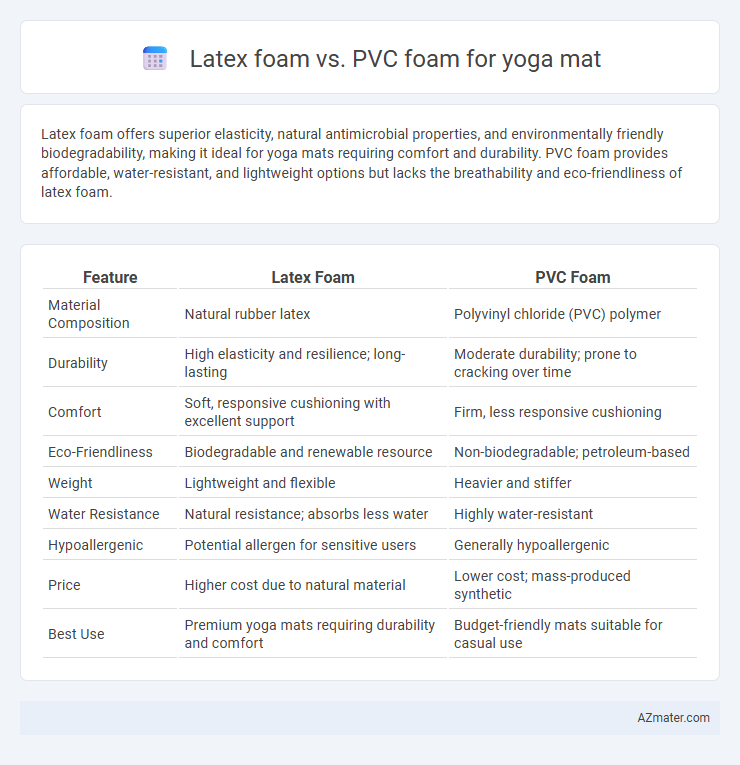Latex foam offers superior elasticity, natural antimicrobial properties, and environmentally friendly biodegradability, making it ideal for yoga mats requiring comfort and durability. PVC foam provides affordable, water-resistant, and lightweight options but lacks the breathability and eco-friendliness of latex foam.
Table of Comparison
| Feature | Latex Foam | PVC Foam |
|---|---|---|
| Material Composition | Natural rubber latex | Polyvinyl chloride (PVC) polymer |
| Durability | High elasticity and resilience; long-lasting | Moderate durability; prone to cracking over time |
| Comfort | Soft, responsive cushioning with excellent support | Firm, less responsive cushioning |
| Eco-Friendliness | Biodegradable and renewable resource | Non-biodegradable; petroleum-based |
| Weight | Lightweight and flexible | Heavier and stiffer |
| Water Resistance | Natural resistance; absorbs less water | Highly water-resistant |
| Hypoallergenic | Potential allergen for sensitive users | Generally hypoallergenic |
| Price | Higher cost due to natural material | Lower cost; mass-produced synthetic |
| Best Use | Premium yoga mats requiring durability and comfort | Budget-friendly mats suitable for casual use |
Introduction to Latex Foam and PVC Foam
Latex foam, derived from natural or synthetic latex, offers exceptional elasticity, durability, and superior cushioning, making it a popular choice for high-quality yoga mats. PVC foam, made from polyvinyl chloride, provides a denser, more affordable option with good slip resistance and moisture resistance but generally lacks the eco-friendly and supportive attributes of latex. Both materials influence the yoga mat's comfort, durability, and environmental impact, guiding consumers toward choices aligned with their practice and preferences.
Material Composition and Source
Latex foam yoga mats are made from natural rubber derived from the sap of rubber trees (Hevea brasiliensis), offering biodegradable and eco-friendly properties. PVC foam mats, composed of synthetic polyvinyl chloride polymers combined with plasticizers, provide durable and moisture-resistant surfaces but lack biodegradability. The natural origin of latex foam ensures better breathability and comfort, while PVC's petroleum-based composition focuses on affordability and easy maintenance.
Environmental Impact and Sustainability
Latex foam yoga mats are made from natural rubber sourced from rubber trees, offering a biodegradable and renewable alternative with minimal environmental toxins. In contrast, PVC foam mats are derived from non-renewable petroleum, involving energy-intensive manufacturing processes that release harmful chemicals and contribute to long-term landfill pollution due to their non-biodegradable nature. Choosing latex foam supports sustainable practices by reducing carbon footprint and waste accumulation compared to PVC foam's considerable environmental impact.
Durability and Longevity
Latex foam exhibits superior durability compared to PVC foam due to its natural elasticity and resistance to cracking, making it ideal for long-term use in yoga mats. PVC foam tends to degrade faster, especially with frequent exposure to moisture and UV light, leading to brittleness and reduced lifespan. The inherent resilience of latex foam ensures better longevity, maintaining structural integrity and cushioning performance over extended periods.
Comfort and Cushioning
Latex foam offers superior comfort and cushioning for yoga mats due to its natural elasticity and responsiveness, providing excellent support for joints during practice. PVC foam, while more affordable and dense, tends to offer firmer cushioning that may not absorb impact as effectively as latex. The breathable structure of latex foam also enhances comfort by reducing sweat and heat buildup compared to the less porous PVC material.
Grip and Slip-Resistance
Latex foam offers superior grip and slip-resistance due to its natural elasticity and textured surface, making it ideal for intense yoga sessions. PVC foam provides moderate grip but tends to become slippery with sweat, reducing stability during poses. Choosing latex foam enhances safety and performance by maintaining traction even in challenging conditions.
Hypoallergenic and Health Considerations
Latex foam yoga mats are known for their hypoallergenic properties, providing natural resistance to dust mites and mold, making them ideal for individuals with allergies or sensitive skin. In contrast, PVC foam mats may release volatile organic compounds (VOCs) that can trigger respiratory issues and skin irritation over time. Choosing latex foam enhances health safety by minimizing exposure to harmful chemicals and promoting a cleaner exercise environment.
Price Comparison
Latex foam yoga mats generally cost more than PVC foam mats due to the natural sourcing and durability of latex, often ranging from $50 to $150. PVC foam mats are typically priced between $10 and $40, making them a budget-friendly option for beginners or casual users. The price difference reflects the material quality, with latex offering better elasticity and eco-friendliness compared to the synthetic nature of PVC foam.
User Preferences and Use Cases
Latex foam yoga mats offer superior elasticity and natural cushioning, preferred by users seeking eco-friendly, hypoallergenic materials for yoga practices involving deep stretches and balance poses. PVC foam mats provide greater durability and moisture resistance, making them ideal for high-intensity workouts and hot yoga sessions where grip and sweat absorption are crucial. User preferences often depend on sensitivity to synthetic materials, desired mat thickness, and the type of yoga style practiced.
Conclusion: Choosing the Right Yoga Mat Material
Latex foam offers superior elasticity, natural antimicrobial properties, and better durability, making it ideal for yogis seeking comfort and hygiene. PVC foam provides affordable, lightweight mats with good cushioning but may lack breathability and sustainability. Selecting the right yoga mat material depends on prioritizing eco-friendliness, durability, and comfort tailored to individual practice needs.

Infographic: Latex foam vs PVC foam for Yoga mat
 azmater.com
azmater.com